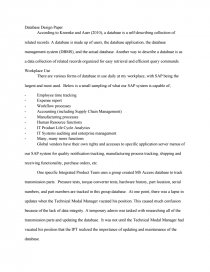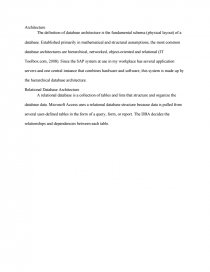Database Design Paper
Essay by Marry • October 10, 2012 • Essay • 374 Words (2 Pages) • 1,841 Views
Database Design Paper
According to Kroenke and Auer (2010), a database is a self-describing collection of related records. A database is made up of users, the database application, the database management system (DBMS), and the actual database. Another way to describe a database is as a data collection of related records organized for easy retrieval and efficient query commands.
Workplace Use
There are various forms of database in use daily at my workplace, with SAP being the largest and most used. Below is a small sampling of what our SAP system is capable of;
- Employee time tracking
- Expense report
- Workflow processes
- Accounting (including Supply Chain Management)
- Manufacturing processes
- Human Resource functions
- IT Product Life Cycle Analytics
- IT Systems auditing and enterprise management
- Many, many more functions
Global vendors have their own rights and accesses to specific application server menus of our SAP system for quality notification tracking, manufacturing process tracking, shipping and receiving functionality, purchase orders, etc.
One specific Integrated Product Team uses a group created MS Access database to track transmission parts. Pressure tests, torque converter tests, hardware history, part location, serial numbers, and part numbers are tracked in this group database. At one point, there was a lapse in updates when the Technical Modal Manager vacated his position. This caused much confusion because of the lack of data integrity. A temporary admin was tasked with researching all of the transmission parts and updating the database. It was not until the Technical Modal Manager had vacated his position that the IPT realized the importance of updating and maintenance of the database.
Architecture
The definition of database architecture is the fundamental schema (physical layout) of a database. Established primarily in mathematical and structural assumptions, the most common database architectures are hierarchical, networked, object-oriented and relational (IT Toolbox.com, 2008). Since the SAP system at use in my workplace has several application servers and one central instance that combines hardware and software, this system is made up by the hierarchical database architecture.
Relational Database Architecture
A relational database is a collection of tables and lists that structure and organize the database data. Microsoft Access uses a relational database structure because data is pulled from several user-defined
...
...

